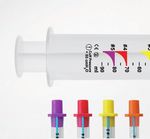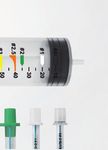LTS-D - Easy insertion Reduction of aerosol spread Atraumatic for patients Effi cient ventilation
←
→
Page content transcription
If your browser does not render page correctly, please read the page content below
Easy insertion
Reduction of aerosol spread
Atraumatic for patients
Efficient ventilation
LTS-D The 2nd generation
supraglottic airway device
VBMLTS-D For use in emergency situations as well as for elective airway management
The Laryngeal Tube LTS-D is a 2nd generation supraglottic airway (with drain tube) and an alternative adjunct to temporarily secure the airway
during emergency situations, e.g. cardiopulmonary resuscitation, in hospital as well as prehospital environments. It is easy to insert and use, even
with minimal training. In situations with limited space or in patients with minimal mouth opening the slim design of the laryngeal tube facilitates
insertion.
Product Features
1 Multiple ventilation outlets for efficient ventilation
2 Drain tube to prevent the risk of aspiration
3 Thin walled cuffs allow maximum airway leak pressure and
reduce the spread of aerosol thanks to efficient pharyngeal
sealing. This is achieved at low cuff pressure (< 60 cm H20)
making the LTS-D atraumatic to the mucosa.
4 Teeth mark as indicator for correct depth of insertion
Drain Tube
D rain tube recommended as current standard in
4
international guidelines. All LTS-D sizes include the drain
tube as standard.
Providing the largest suction capability with easy access can
accomodate up to 18 Fr gastric tube
Gastric Tube
Insertion of a gastric tube is helpful to confirm correct
placement of the LTS-D
1
3
2Video animation Application video
The teeth mark is an indicator regarding the correct depth of insertion and for orientation and repositioning purposes. The colour coded system
hasproveninvaluableinemergenciesasthesyringeandconnectorsindicatetherecommendedmaximuminflationvolume.
Clinical Features
Higher Survival Exchange of LTS-D for Tracheal Tube
Higher 72-hour survival in adults with OHCA (LTS-D P ossibilityofexchangingtheLTS-D(insituwithdeflated
compared to ETI) cuffs) for a Tracheal Tube using Video Laryngoscopy and a
Bougie
18,3%
A RANDOMIZED 15,4%
CLINICAL TRIAL
3004 PATIENTS
SUPERIOR
OUTCOME
72-HOUR
SURVIVAL
LTS-D ETI
Reduction of Aerosol Spread
The application of the LTS-D in combination with a
breathingsystemfilterleadstoaremarkablereductionof
aerosol spread during aerosol generating procedures (AGP)
e. g. chest compressions
No-flow-time
Easy to insert especially in cases of cardiac arrest without
interruptionofchestcompressions.Thisleadstosignificant
reductioninno-flow-time.
Uninterrupted Chest Compressions
Due to a very high airway leak pressure, uninterrupted chest
compressions during CPR are possibleOrder Information
LTS-D
Size Patient Weight / Colour LTS-D Single-Set LTS-D Set of 10 LTS-D Emergency- Drain Fiber-
Height with colour coded Set with colour tube scope
syringe coded syringe
0 Newborn < 5 kg REF 32-06-100-1 REF 32-06-000-1 10 Fr < 3.0 mm
1 Infant 5 – 12 kg REF 32-06-101-1 REF 32-06-001-1 Child 10 Fr < 3.0 mm
(# 0, 1, 2, 2.5)
2 Child 12 – 25 kg REF 32-06-102-1 REF 32-06-002-1 REF 32-06-309-1 16 Fr < 4.0 mm
2.5 Child 125 – 150 cm REF 32-06-125-1 REF 32-06-025-1 16 Fr < 4.0 mm
3 Adult < 155 cm REF 32-06-103-1 REF 32-06-003-1 18 Fr < 6.0 mm
Adult
4 Adult 155 – 180 cm REF 32-06-104-1 REF 32-06-004-1 (# 3, 4, 5) 18 Fr < 6.0 mm
REF 32-06-209-1
5 Adult > 180 cm REF 32-06-105-1 REF 32-06-005-1 18 Fr < 6.0 mm
Connector and syringe are colour coordinated
References
References and algorithms for supraglottic airways with suction possibilities
T. M. Cook et al., “Major complications of airway management in the UK: results of the Fourth National Audit Project of the Royal College of Anaesthetists
andtheDifficultAirwaySociety.Part2:intensivecareandemergencydepartments,”Britishjournalofanaesthesia,vol.106,no.5,pp.86–95,2011.
Timmermann et al., S1-Leitlinie: Prähospitales Atemwegsmanagement. Anästh Intensivmed 2019.
International guidelines recommend the LT as an alternative device during CPR to secure the airway
M. S. Link et al., “Part 7: Adult Advanced Cardiovascular Life Support: 2015 American Heart Association Guidelines Update for Cardiopulmonary
ResuscitationandEmergencyCardiovascularCare,”Circulation,vol.132,no.18,444-464,2015.
J.Soaretal.,“EuropeanResuscitationCouncilGuidelinesforResuscitation2015:Section3.Adultadvancedlifesupport,”Resuscitation,vol.95,pp.
100–147, 2015.
Airway management after Emergency Department (ED) arrival
R.Schalketal.,“UmintubationmithilfedesC-MAC-Videolaryngoskops,”DerAnaesthesist,vol.61,no.9,pp.777–782,2012.
B.E.Driveretal.,“EmergencyDepartmentManagementofOut-of-HospitalLaryngealTubes,”Annalsofemergencymedicine,vol.74,no.3,pp.403–409,
2019.
Emergency Airway Management
H.Genzwürker,“PräklinischerEinsatzvonsupraglottischenAtemwegsalternativen,”NotfallRettungsmed,vol.14,no.1,pp.21–24,2011.
Adjunct during CPR
C.H.R.Wieseetal.,“Usingalaryngealtubeduringcardiacarrestreduces"noflowtime"inamanikinstudy:acomparisonbetweenlaryngealtubeand
endotrachealtube,”WienerklinischeWochenschrift,vol.120,7-8,pp.217–223,2008.
H. E. Wang et al., “Effect of a Strategy of Initial Laryngeal Tube Insertion vs Endotracheal Intubation on 72-Hour Survival in Adults With Out-of-Hospital Cardi-
acArrest:ARandomizedClinicalTrial,”JAMA,vol.320,no.8,pp.769–778,2018.
M.Ottetal.,“Explorationofstrategiestoreduceaerosol-spreadduringchestcompressions:Asimulationandcadavermodel,”Resuscitation,2020.
Ott M, et al. Exploration of strategies to reduce aerosol-spread during chest compressions: A simulation and cadaver model. Resuscitation (2020)
Thisproductismanufacturedwithouttheuseofnaturalrubberlatex,unlessotherwisespecified.
This product does not contain phthalates which require labelling according to CLP Regulation (EC) 1272/2008.
VBM Medizintechnik GmbH
Connect with us:
Einsteinstrasse 1 | 72172 Sulz a. N. | Germany
Tel.: +49 7454 9596-0 | Fax: +49 7454 9596-33 | e-mail: info@vbm-medical.de | www.vbm-medical.de PRO003_3.0_ENYou can also read
























































